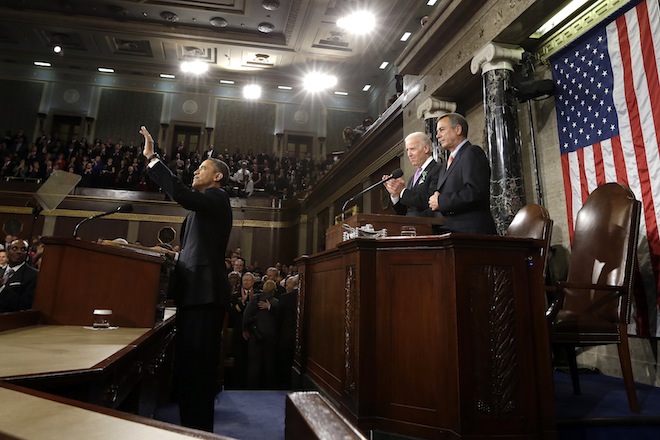For the first time since his first joint address to Congress at the beginning of 2009, President Obama used his State of the Union Address Tuesday to go beyond reprising his presidential aspirations.
Though the address detailed a raft of policy ideas – most of which he’s proposed before, many of which Congress has declined to act upon – he notably used it as an opportunity to explain the sequester to an audience of millions, many of whom may be unaware that a political impasse with congressional Republicans is once again threatening to damage the economy, in less than three weeks.
This required turning back the clock to the dark days after the 2010 midterms.
“In 2011, Congress passed a law saying that if both parties couldn’t agree on a plan to reach our deficit goal, about a trillion dollars’ worth of budget cuts would automatically go into effect this year,” Obama explained.
These sudden, harsh, arbitrary cuts would jeopardize our military readiness. They’d devastate priorities like education, energy, and medical research. They would certainly slow our recovery, and cost us hundreds of thousands of jobs. That’s why Democrats, Republicans, business leaders, and economists have already said that these cuts, known here in Washington as “the sequester,” are a really bad idea.
Now, some in this Congress have proposed preventing only the defense cuts by making even bigger cuts to things like education and job training; Medicare and Social Security benefits.
That idea is even worse.
In a background briefing for reporters at the Eisenhower Executive Office Building on Tuesday afternoon, a senior administration official described the address as a major facet of the president’s ongoing strategy of using his bully pulpit to scare Republicans off of their anti-tax negotiating demands. Obama executed the strategy successfully during the fiscal cliff fight, when Republicans initially rejected higher income tax rates; and during the fight over the debt limit, which the GOP once refused to increase unless paired with concomitant spending cuts.
Officials hope a similar dynamic will force the GOP off of its insistence that the sequester be replaced either with an equal number of cuts to domestic programs, or not at all. But they acknowledge that Obama has no direct power to blunt the sequester’s economic consequences.
The sequester is the largest single threat to the rest of Obama’s agenda, which is premised on the idea that the government can spend the next year fostering a growing economy rather than struggling to prevent a self-inflicted recession.
The address laid out a series of domestic goals, divided roughly between issues (such as greenhouse gas emissions) on which Obama can make some progress on his own, and others (like deficit reduction) which Congress controls nearly completely.
“I urge this Congress to pursue a bipartisan, market-based solution to climate change, like the one John McCain and Joe Lieberman worked on together a few years ago,” Obama said, referring to legislation designed to cap greenhouse gas pollution and allow emitters to sell and purchase emission permits. “But if Congress won’t act soon to protect future generations, I will direct my Cabinet to come up with executive actions we can take, now and in the future, to reduce pollution, prepare our communities for the consequences of climate change, and speed the transition to more sustainable sources of energy.”
Beyond the realm of his executive powers Obama proposed initiatives to fix structurally deficient roads and bridges, promote energy efficiency programs in states, reform the immigration system, and provide universal preschool and other education investments.
All of these goals, he pledged, would be deficit neutral. His speech clarified that he plans to abide by discretionary spending caps he agreed to in the 2011 debt limit deal; and according to a senior administration official, his proposals for new mandatory initiatives would be more than offset by changes he’s proposed to Medicare and other auto-pilot spending programs.
Not all of Obama’s proposal were fiscal in nature. He called for votes in Congress to raise the minimum wage, and link it to the cost of living, on gun control, and, eventually, on a election reforms that will expedite voters’ access to the polls.
But his carrot and stick approach to future legislative goals is premised on the notion that the sequester does not overwhelm domestic policy this year. And though Obama’s main weapon in that fight is direct communication with voters, he also reminded congressional Republicans, subtly, that he still holds the veto pen.
“[S]ome in this Congress have proposed preventing only the defense cuts by making even bigger cuts to things like education and job training; Medicare and Social Security benefits,” Obama warned. “That idea is even worse.
[W]e can’t ask senior citizens and working families to shoulder the entire burden of deficit reduction while asking nothing more from the wealthiest and most powerful. We won’t grow the middle class simply by shifting the cost of health care or college onto families that are already struggling, or by forcing communities to lay off more teachers, cops, and firefighters. Most Americans – Democrats, Republicans, and Independents – understand that we can’t just cut our way to prosperity. They know that broad-based economic growth requires a balanced approach to deficit reduction, with spending cuts and revenue, and with everybody doing their fair share. And that’s the approach I offer tonight.










